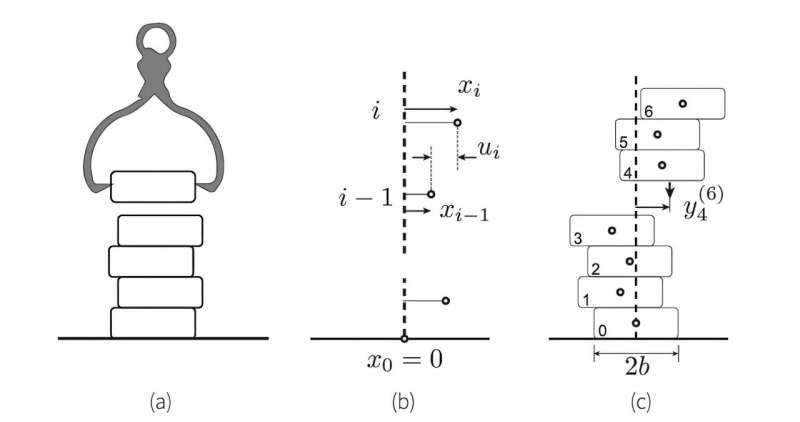
December 17, 2024 by University de Liege
Collected at: https://phys.org/news/2024-12-physics-random-stacking-perspectives-stability.html
Pile up blocks until the tower collapses. But why does the tower always end up collapsing? Is it possible that it can be built ad infinitum? A study published in the International Journal of Solids and Structures explores the fascinating and complex dynamics of the stacking of blocks subjected to hazards. Carried out by Vincent Denoël, an engineer at the University of Liège, this research looks at the stochastic stability of stacks, providing crucial insights for engineering, construction and materials science.
Imagine a tower of kaplas (identical wooden planks) with each block slightly out of alignment. As the tower rises, the misalignment increases until an inevitable breaking point is reached, a situation familiar to all kapla fans. This simple phenomenon, which echoes the games of our childhood, raises a question of stability: how high can the blocks be stacked before the structure collapses?
Denoël, an engineer in the SSD (Structural & Stochastic Dynamics) laboratory at the University of Liège, set out to gain a better understanding of these failures in order to develop a statistical model that could accurately predict the critical height and failure points by looking at a random stacking of blocks in a configuration where each block is slightly misaligned. So how do small positioning errors when stacking blocks influence the overall stability of the stack?
“Modeled as Gaussian random variables, these errors lead to progressive misalignments that inevitably lead to collapse,” explains the researcher. “This problem goes beyond the simple child’s game of stacking objects; it is a scientific challenge with major implications. From the construction of dry masonry walls to the optimization of automated storage systems, understanding the probabilistic nature of these collapses can improve safety and efficiency in a variety of fields.”
Denoël has modeled this as a “first-pass problem,” a probabilistic approach to analyzing the conditions leading to system failure. “As blocks are added, random misalignments gradually modify the stack’s center of gravity. When this exceeds a critical limit, the stack collapses.”
This approach revealed two main areas of vulnerability: the base of the stack, where cumulative errors become unsustainable, and an intermediate zone, where hidden instabilities accumulate insidiously.
The maximum height of a pile before it collapses is inversely proportional to the square of the amplitude of the positioning errors. Thus, small errors allow much greater heights to be reached, while larger errors lead to rapid collapse. Monte Carlo simulations, used to validate the theoretical model, were used to visualize the behavior of the piles. These simulations confirmed the bimodal nature of the failure points, for a given drop height, and highlighted the distribution of weak interfaces within the piles.
This research is not limited to abstract modeling. It has many practical applications. In construction, for example, the results may help to design more stable structures, even in the presence of small imperfections.
In automated warehouses, where precise stacking of goods is essential, the probabilistic models resulting from this study could reduce the risk of collapse. Furthermore, in emerging fields such as nanotechnology, where precision is crucial, this study could inspire new strategies for optimizing the arrangement of layers of material deposited on a microscopic scale.
Beyond its practical implications, this study illustrates how an apparently trivial question can lead to fundamental discoveries. By combining tools from mechanics, system dynamics and probability theory, the research opens up new perspectives on the interactions between randomness and stability. It also highlights a universal lesson: unpredictability, when properly understood, can be harnessed to produce more robust systems.
This study sheds new light on the stability of random structures. It not only provides tools to predict and prevent collapse, but also shows how imperfect systems can be optimized through a better understanding of their intrinsic dynamics. This work provides a bridge between scientific curiosity and practical application, demonstrating once again that even seemingly simple questions can lead to major breakthroughs.
More information: V. Denoël, Stochastic stability of random stacking of blocks, International Journal of Solids and Structures (2024). DOI: 10.1016/j.ijsolstr.2024.113094

Leave a Reply